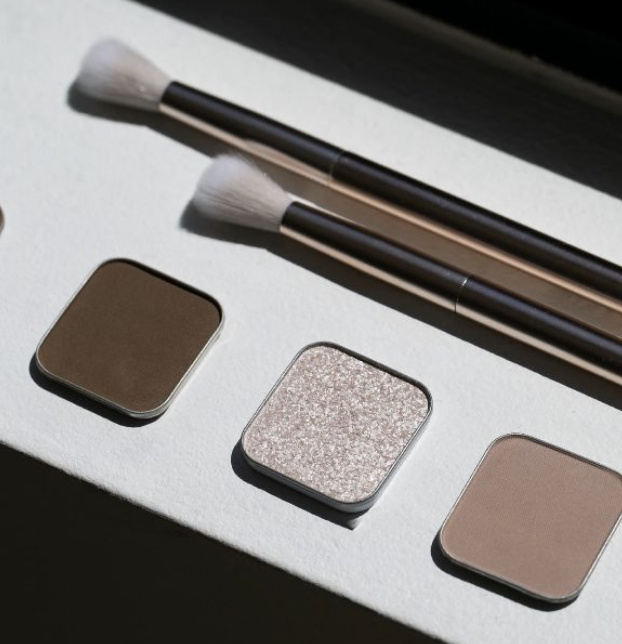With this makeup line, you get to build your own eyeshadow palette with colors you’ll actually use, and bonus everything is magnetic and easy to replace so no more wasting compacts too! All these eyeshadows are so easy to mix + match and build on. The colors are highly pigmented, don’t have fall out, blend beautifully, and are much bigger than traditional eyeshadows which means they’re gonna last ya at least a year with frequent use.
To elevate your eyeshadow game, grasping the fundamentals of building and blending is essential. Initiate your eyeshadow routine by selecting a transition shade that effortlessly complements your skin tone. This foundational step is critical for adding depth and creating a natural gradient effect in your crease. As you move forward, introduce darker shades to intensify the look, ensuring that each addition is meticulously blended to eliminate any stark lines. Blending should be performed with gentle, circular motions, allowing the colors to merge seamlessly for a cohesive appearance.
Employing the right tools can significantly impact the effectiveness of your blending technique. Opt for a fluffy blending brush for softer transitions and a more precise brush when adding depth in specific areas. The distinction between these tools and their correct usage plays a pivotal role in achieving a flawless finish.
Moreover, don’t shy away from revisiting the lighter shades to refine the gradient or highlight certain parts of your eyelid, like the brow bone or the inner corner of the eye. This layering approach not only enhances the complexity of your eyeshadow look but also ensures a balanced and harmonious outcome. Remember, the art of building and blending is a practice of patience and precision, aiming to enrich the natural beauty of your eyes without overwhelming them.
The transition shade plays an indispensable role in crafting a nuanced eyeshadow look that effortlessly flows from the eyelid to the brow bone. Selecting the right transition shade involves finding a hue slightly darker than your skin tone but still within the same color family as your other eyeshadow selections. This careful choice facilitates a smooth gradient effect, crucial for adding dimension without creating a harsh divide between shades.
When applying the transition shade, start in the crease of your eye, using a windscreen wiper motion with a fluffy blending brush. This technique ensures that the color diffuses evenly across the crease, acting as a seamless bridge between the lighter lid color and the darker crease shade. The success of your eyeshadow look hinges on the seamless integration of this shade; it’s the backbone that supports both the structure and harmony of your overall application.
Beyond merely acting as a mediator between colors, the transition shade can also redefine the appearance of your eye shape. By adjusting the height and intensity of this shade, you can create the illusion of deeper set or more lifted eyes, tailoring your makeup to enhance your natural beauty. This level of customization is what makes mastering the transition shade a game-changer in your eyeshadow routine.

Step 1: Start with priming your lid (I use my foundation shade with setting powder over top)
Step 2: Darkest shade
Paint the darkest shade in a vertical line on the outer part of the eye (Filly)
Step 3: Warm shade
Paint the warm shade next to the darker shade (Sedona)
Step 4: Darker shimmer
Then paint your darker shimmer next to your warm shade (Bright Eyes)
Step 5: Warmer shimmer (Sabrina)
Apply to inner corner of the eye
Step 6: Blend inward
Navigating the pitfalls of eyeshadow application requires attention to detail and an understanding of common missteps. One frequent error is overloading the brush with product, leading to fallout beneath the eyes and an overly intense look that can be challenging to correct. Begin with a light touch, gradually building color to achieve the desired intensity. Another common oversight is neglecting the importance of blending. Harsh lines and unblended patches can detract from the beauty of your eyeshadow work, creating a disjointed appearance. Utilize a clean blending brush to soften edges and ensure a harmonious transition between colors.
Equally crucial is the choice of appropriate brushes for different eyeshadow techniques. Using a brush that’s too large for detailed work, or too small for blending, can compromise the final look. Invest in a variety of brush sizes and shapes to suit each step of your application, from laying down the base color to defining the crease and blending out transitions.
Lastly, skipping primer is a misstep that can affect the longevity and vibrancy of your eyeshadow. A thin layer of primer prepares the eyelid by creating a smooth canvas, enhancing color payoff, and preventing creasing throughout the day. By steering clear of these common mistakes, you enhance the overall quality and endurance of your eyeshadow looks.